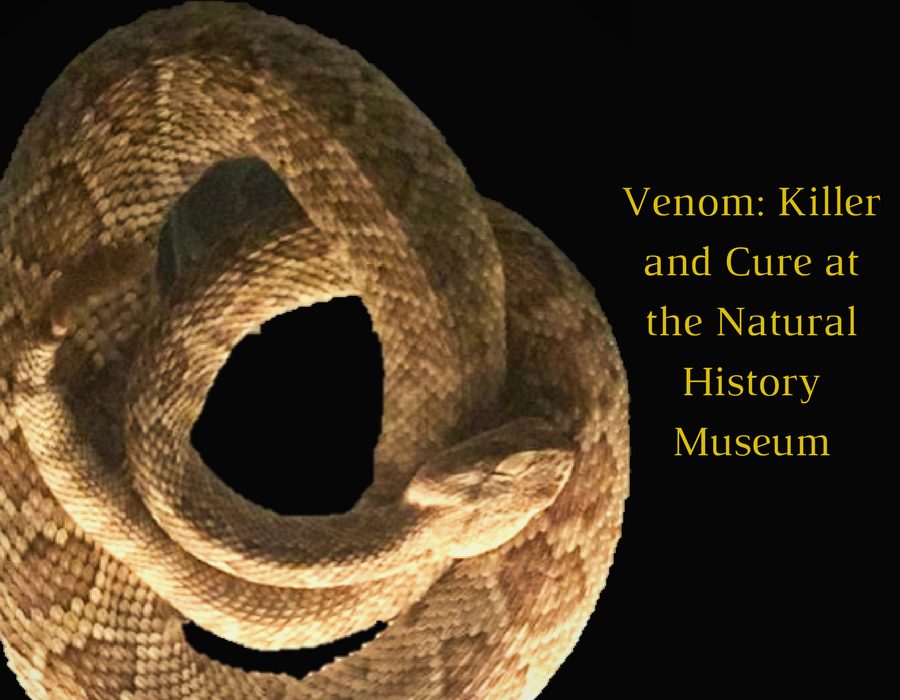Roisin Conneely

The natural world never ceases to amaze us with the plethora of adaptations that creatures have evolved in order to survive at all costs, and the evolution of venom is one such tool that countless species employ to ensure they live to fight another day.
Venom: Killer and Cure is on at the Natural History Museum (London) until 13th May 2018, so you have a few days left to check it out. But if you can’t make it, check out our thoughts on the exhibition with our summary of some of the best bits. Don’t forget to head over to our Instagram for some photos of our trip to the museum, which you’ll find in the “highlights” section of our profile!
Upon entering the exhibition, your senses are immediately under attack, the room is almost pitch black and large screens show projections of mosquitoes with their endlessly squirming legs, along with accompanying tropical noises, it’s certainly very atmospheric.
The exhibit begins by reminding us that most seemingly scary species, such as the Burgundy goliath bird-eating tarantula (Theraphosa stirmi), are actually harmless to us, but we have evolved to perceive them as threats. Our early arachnophobic ancestors with a keen eye for spiders and other potentially dangerous species would have stood a better chance at survival than other more fearless, and careless individuals. A nice little link to our history and evolution to kick of the exhibit, I thought, and a reminder that fear is actually a useful tool.
The exhibition is neatly separated according to the several different uses of venom, so let’s jump straight in and examine some of the highlights from them all.
Defence
Scorpion beetle (Onychocerus albitarsis)

Native to Peru, the scorpion beetle is the only venomous species of beetle in the world. It’s piercing antennae deliver venom as a defence mechanism. It is so called because of convergent evolution with the scorpion which has led to them both developing similar morphologies.
Bruno’s casque-headed frog (Aparasphenodon brunoi)

Found within the forests of Brazil, Bruno’s casque-headed frog is a small tree frog which injects venom into pretty much anything it feels threatened by. It does this in a rather unusual manner – by headbutting predators with its spiky skull bones.
Whilst many frogs are poisonous, (you bit it and you die, versus venom where it bites you) this is one of the most lethal venomous frogs in the world, with venom 25 times deadlier than that of the Brazilian pit viper.
Iberian ribbed newt (Pleurodeles walti)

One of only two known genera of venomous newts, the Iberian ribbed newt is found throughout Morocco and Spain, and when it feels threatened, its ribs will burst out of their skin (which also happens to be covered in poison, just in case), in order to stab their attackers.
Hunting
Gaboon viper (Bitis gabonica)

Probably one of the most captivating displays in the collection, the gaboon viper head certainly leaves an impression. The viper attacks its prey by rapidly snapping on to them and injecting a mixture of toxins. Afterwards, the viper forks its large fangs back into its mouth, unhinges its jaws and swallows prey whole.

While we’re on the topic of vipers, another interesting item on display was the fossil viper fang, dated at approximately 18 million years old. Discovered in France, this is one of the oldest known examples of a fossil venomous fang. Although it is tricky to determine when venomous snakes evolved, this fossil demonstrates that specialised structures for venom injection had evolved in snakes by the Miocene. This delivery system has since evolved in three lineages of snake; vipers, burrowing asps and elapids.
Zombifying
Sometimes plain old fashioned killing of prey just won’t do, and certain creatures find themselves needing to paralyse or “zombufy” their prey instead. This is most common in species with fast metabolisms needing to consume huge supplies of food, or those that have to stock up on food stores for their offspring. Usually these species store their prey, utilising venom to immobilise it, so that it stays alive and fresh for when dinner time arrives. Interestingly, shrews and moles are actually known to use venom in this wat.
Emerald cockroach wasp (Ampulex compressa)

The emerald cockroach wasp stings cockroaches to temporarily paralyse them. They then inflict a second sting which targets the brain, zombifying it and inhibiting its escape behaviour. For unknown reasons, stinging also provokes the cockroach to start grooming itself. The wasp then leads the roach to a buroow, lays its eggs on it and seals it in. The wasp larva then hatches and eats the cockroach alive. Talk about a ready meal.
Mating and competition
Emperor scorpion (Pandinus imperator)

These scorpions employ venomous stings during a courtship dance termed the “promenade a deux”. The male inserts his sting into the female, gripping her claws and guiding her towards his “sperm package” (no, we’re not making this up), deposited on the floor. Research suggests that the males’ sting may sedate the female, making her easier to manoeuvre to the “package” and also reducing the chances of her killing him.
Platypus (Ornithorhynchus anatinus)

The (male) platypus is one of the few venomous species of mammal. They have spurs on their feet that are attached to venom glands, which may be used to deter predators, but are mainly used during the mating season to fight other males for access to females and win territories. Females do not have these venomous glands, and outside of the mating season, the males’ glands become inactive and shrink.
Greater slow loris (Nycticebus coucang)

During competition for females, male slow lorises lick the venomous glands on their elbows and then bite other males, inflicting, non-healing wounds. If you’ve ever seen images of slow lorises with their arms raised, this is not a cute invitation for a hug, but is in fact a warning sign – their venom can be lethal to humans.
Blood feeding
Sheep ticks (Ixodes ricinus)

These pesky ticks insert venom through painless bites, which promote blood flow in their victims, including species such as sheep, deer, dogs and humans. The venom contains toxins which in rare cases can cause paralysis, resulting in respiratory failure and even death. They are also capable of transmitting potentially lethal diseases such as Lyme disease.
Common vampire bat (Desmondus rotundus)
Foun d in Central and South America – these bats feed on blood of birds, mammals and livestock. They make an incision into their victims flesh using their teeth. Whilst their tongues flick in and out of the wound, toxins pour into the victim which reduce pain, suppress their immunity and prolong blood flow so they can feed for longer.
d in Central and South America – these bats feed on blood of birds, mammals and livestock. They make an incision into their victims flesh using their teeth. Whilst their tongues flick in and out of the wound, toxins pour into the victim which reduce pain, suppress their immunity and prolong blood flow so they can feed for longer.
Venomous humans

This for me was the most surprising and thought provoking elements of the whole exhibition. The weapons and armory employed by early and modern humans was framed as a sort of self-engineered adaptation. For example, prehistoric humans may have dipped their arrows in poison, thereby turning poison into a venomous substance by actively injecting it into a wound. Lots of modern hunter-gatherers still employ similar methods, so maybe we can be considered a venomous species under certain circumstances…?
Amazonian arrows & quiver – from the Mawayana people of South America. The arrows were used attack prey, and were likely poisoned with curare, a mixture of lethal plant extracts. This is ideal for for hunting as it is only toxic if it enters the blood but causes no unwanted effects if ingested.
Poison arrows from San hunter-gatherers – South African poison arrows fired at prey to weaken and kill it. San hunter-gatherers of South Africa often utilise lead beetle larvae of the genus Diamphidia, using their toxic body fluids to coat their arrows. The venom can rupture red blood cells, causing paralysis and lead to a slow and painful death.
Venomous cocktails
Haemotoxins

Venoms which target the circulatory system contain haemotoxins, which may destroy red blood cells, disrupt blood flow or prevent clotting. Many snakes employ haemotoxic venom, including the western diamondback rattlesnake (Crotalus altrox), which primarily uses its venom to catch mice, but may also attack humans, in defence. Their venom contains approximately 24 different toxins.
Cytotoxins

The stonefish (synanceia horrida), uses cytotoxins, which rupture cells and kills them. The venom of the stonefish is released as a defensive mechanism, and contains one killer ingredient known as stonustoxin which acts by puncturing cell membranes. Stepping on the spines of a stonefish can bring about hallucinations, or even death.
Neurotoxins

Neurotoxins are perhaps the scariest of all, targeting the nervous system and interfering with the transmission of neuronal impulses which can lead to paralysis. The geography cone snail (Conus geographus) produces two types of neurotoxic venom, one for attacking and one for defending. Both comprise hundreds of toxins and are able to paralyse fish. They can also kill humans rapidly, with their defensive venom being 350 times more powerful than it predatory mixture.
 Another interesting feature of the exhibition is the art installation depicting a battle between a cobra and a mongoose. The accompanying audio commentary provided by Dr Ronald Jenner (Natural History Museum) is rather surprising, as he informs the listener that he would put his money on the mongoose winning the bout. Cobra venom contains a neurotoxin which block reception of nerve endings in muscles, paralysing their prey. However, the mongoose has evolved a mutation in the nicotinic acetylcholine receptor which renders them immune to snake venom, meaning they don’t get paralysed by the cobra bite and can actually turn on the snake and eat it themselves. Got to love a win for the underdog (or undergoose).
Another interesting feature of the exhibition is the art installation depicting a battle between a cobra and a mongoose. The accompanying audio commentary provided by Dr Ronald Jenner (Natural History Museum) is rather surprising, as he informs the listener that he would put his money on the mongoose winning the bout. Cobra venom contains a neurotoxin which block reception of nerve endings in muscles, paralysing their prey. However, the mongoose has evolved a mutation in the nicotinic acetylcholine receptor which renders them immune to snake venom, meaning they don’t get paralysed by the cobra bite and can actually turn on the snake and eat it themselves. Got to love a win for the underdog (or undergoose).





Venom: Killer and Cure (Natural History Museum) Review — Seeking Science – In The Mind Library
[…] via Venom: Killer and Cure (Natural History Museum) Review — Seeking Science […]
Venom: Killer and Cure (Natural History Museum) Review Part 2 – Seeking Science
[…] part 1 of our review of the Natural History Museum’s “Venom” exhibition, we explored the diversity […]
Hosn
And here i thought platypodes were meant to be cute…
Great range of animal classes in relation to this topic 🙂